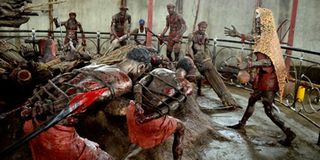Reliving the martyrs’ torture story

Sculptures depicting the martyrs being led to the furnace by Mukajanga (R) and his henchmen at the Uganda Martyrs Museum at the Anglican Shrine in Namugongo. Photo by Dominic Bukenya.
What you need to know:
The martyrs story. Pope Francis will today open the new Uganda Martyrs Museum at the Anglican Shrine in Namudongo. The museum is designed to remind the believers about the suffering the martyrs went through, writes Douglas D. Sebamala.
Namugongo’s economic potential is more appreciated in the season ahead of the martyr’s pilgrimage every June 3.
But Pope Franci’s visit this weekend is going to multiply these returns in more ways than the country has seen in years, especially with the opening of the Ugandan Martyrs Museum at the Anglican Church (shrine).
The museum adds to the collection of countable museums in the country, including Uganda National Museum on Kitante Road in Kampala and the Nebbi Paleontological Centre, where a 20 million-year-old skull was excavated by the French mission in Uganda.
“This shall add to the tourism potential that this story [martyrs story] has and also create income that can be used to develop the church and support the Christian establishments in Namugongo,” said Rev Henry Seggawa of Uganda Martyrs Chruch of Uganda, Namugongo.
Where the museum now sits was a set of huts depicting premises of the chief executioner, Mukajanga, who carried out Kabaka Mwanga’s orders to kill the martyrs. The huts have transformed into large concrete walls, whose interior roofing is held together by metallic bars that still create the illusion of a hut. The roof is a shade of dark maroon with a grey peak towering a cross.
Artistic impressions
The story following the torture and killing of these martyrs, whose missionary beliefs defied the Kabaka, has been aligned in the museum. To the right, the initial tree where they were beheaded and tortured has been enlarged with clay mold. To create a more artistic piece, it is now surrounded by sculptures of Buganda soldiers beating and piercing the martyrs with spears, battering them.
There are at least 20 artistic impressions of the martyrs in this space. The distinct figure of Mukajanga has been given a bright yellow back cloth. He holds a black gourd, (Ndeku) with a smoking pipe, (Mindi) in his mouth as he hurls commands to the soldiers; albeit to increase fires in the furnace or batter teh martyrs into denouncing Christianity.
At one end, a prison where they were held is curved into the wall, a few metres away from the reed thatch court where Mukajanga sat, guarded by two soldiers with spears at the entrance.
“It has taken seven months to get these sculptures ready. They have been molded from clay and painted to give the blood visual appeal,” Matthew Kimbugwe, one of the artists, said.
Round the scotching furnace is a trail of martyrs being dragged to the fire, and another on his knees receiving a beating, with his hands chained to the back.
Just adjacent the museum, there is the martyrs chapel outside, commonly referred to as The Martyrs’ Memorial church. At the altar of this chapel is where the remains of the killed martyrs were buried. There is a plaque in this same chapel that was donated by Pope Paul VI in 1969.
Purpose
The museum is geared to reminding believers about the road to martyrdom.
Pope Francis will today officially unveil the pieces.
Visual addition to a story many Ugandans already know is drawing a more realistic and emotional effect to the Namugongo martyrs.
“Even in their incomplete state, these sculptures feel like the real thing, I cried looking at one of the men who was pierced from the back through to his chest. That should have hurt. They endured a lot of pain for their faith,” Liz Akello, a believer, said.
The four significant features in the museum
There are four spots with historical structures that are being enhanced inside this museum.
The furnace: The last spot within the museum is the furnace where some convicts were burnt to death.
The holding cell: The third location is the prison where some convicts were kept on reaching Namugongo before meeting their final punishment.
Torture tree: The second spot is where the torture tree called Ndazabazadde .This was where the convicts were killed either by dismembering their bodies or spearing them and then leaving them to die slowly.
Mukajanga, the chief executioner’s home: “A hut is being constructed with a large opening so that not only the Pope is able to see what is inside, but other visitors too. Some of the items that will be in there include the tools that Mukajanga and his men used during execution,” says Rev Esau Bbosa Kimanje, the assistant vicar.
Additional reporting by Esther Oluka




